#Beaumont and Fletcher
Photo
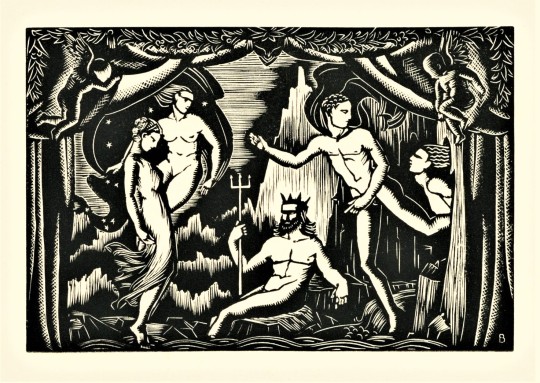



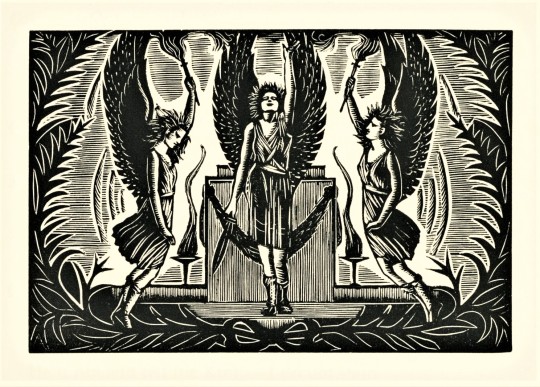
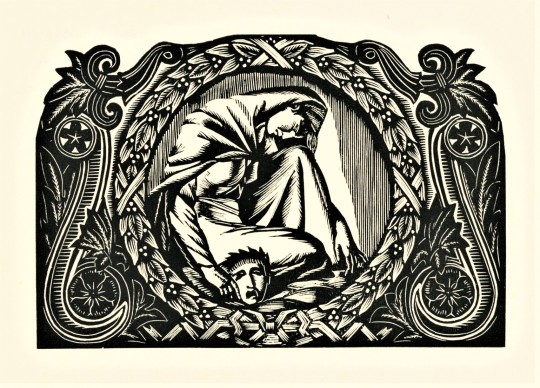
Wood Engraving Wednesday
FREDA BONE
This week we present wood engravings by Irish painter, illustrator, and wood engraver Freda Bone (1905-1991) from a 1932 edition of early 17th-century playwrights Francis Beaumont and John Fletcher’s play The Maides Tragedy, printed in an edition of 1200 copies by Richard W. Ellis for Cheshire House in New York. Unfortunately, we can find very little about Freda Bone’s life and career, even though she was a much sought after woodcut and wood-engraving illustrator. Still, we are delighted by the energy and symmetry of her compositions. If anyone has more information on Bone, we would appreciate if you would contact us.
View more posts with work by women wood engravers.
View more Women’s History Month posts.
View more posts with wood engravings!
#Wood Engraving Wednesday#wood engravings#wood engravers#women wood engravers#Freda Bone#Francis Beaumont#John Fletcher#Beaumont and Fletcher#The Maides Tragedy#The Maid's Tragedy#Richard W. Ellis#Cheshire House#fine press books#women's history month
82 notes
·
View notes
Text

Hence, All Ye Vain Delights by Francis Beaumont and John Fletcher, from The Family Library of Poetry and Song edited by William Cullen Bryant, 1886
#quote#typography#literature#beaumont and fletcher#francis beaumont#john fletcher#aesthetic#dark academia#william cullen bryant#the family library of poetry and song#dark things#1600s#17th century#english literature#english poetry
5 notes
·
View notes
Link
Shakespeare wrote his late plays – plays of spectacle and reconciliation written between 1608 or so and 1613 – both for the Globe and for the company’s new indoor playing space, the Blackfriars. Critics have traditionally read these plays as dramatising sincere, transcendent emotions and one emotion above all – wonder – by contrasting them with what they saw as the insincerity of the Fletcher plays, which cannot resist showing the mechanisms of things, how events work out through material motivations.
#shakespeare#william shakespeare#winter's tale#the winter's tale#beaumont#fletcher#shakespeare's globe#blackfriars
13 notes
·
View notes
Text
... Men that make
Envy and crooked malice nourishment
Dare bite the best.
Cranmer, Archbishop of Canterbury in The Famous History of the Life of Henry VIII by Shakespeare and Fletcher
#shakespeare#henry viii#poetry#blank verse#i can never remember fletcher's first name. i forget if it's thomas or john#one of those im quite sure. and if im wrong i truly am an idiot#i just think of him as fletcher from 'beaumont and'#i remember beaumont's first name bc francis beaumont is honestly kind of a bitchin name for a playwright#thomas/john fletcher(? i wanna say it's john) could be anybody#no wonder he had to cowrite#john fletcher#im taking the leap. and if im wrong ill change that tag later lol#jacobean literature
1 note
·
View note
Text
A bit about lost plays of the 'early modern' period.
#shakespeare#cardenio#lost plays#fletcher#english literature#history#folger shakespeare library#wild goose chase#beaumont
1 note
·
View note
Text

are not her breasts two liquid ivory balls.
#i don't even know what to do with this i'm not even laughing#i wish beaumont and fletcher were alive so i could kill them again. what the fuck guys#my posts
1 note
·
View note
Link
This is a captivating play with beautiful language. Each character, even the smallest ones, have depth, and the emotional journeys the characters undergo is moving and feels real. The struggle between the morally correct and sinfully pleasurable is invigorating rather than by the numbers, primarily due to the different ways the two kings approach this tug of war. It's a very unheard of work, but it matches Shakespeare's wit, dimensionality, and dramatic intensity.
0 notes
Text
❀ MAYPOST ❀
Below is an article of mine I’ve shared before, about how Wiccans (especially those outside of the UK) have a skewed perception of May Day that does not necessarily reflect surviving traditions. This was long before the TERFs really started to take hold over the “nature-based” demographics; many of these harmless folk customs would be outlawed if they had the power to do so. Anyway, here it is in full, because nobody wants to click through a bunch of links. (archived here)
❀
Some time ago, I began to question what I've generally been told about British folk traditions. May Day, for example. I was so busy re-educating myself about folk festivals in Gaelic cultures, that I never stopped to question what I knew about British ones. My following visit to Wikipedia was illuminating.
Here are some things I was surprised to learn.
1. May Day is feminine and twee by today's standards.
At a neopagan festival, you're likely to encounter a maypole, and any dancing that occurs will be performed in the weaving of the ribbons around it. In England, there's a lot more dancing. Elaborately choreographed dancing. Young and old folks dancing. With bells. And ribbons. And wands. And little hankies. And flowers. Flowers on hats. Men's hats.
These Cotswold dancers, for example. Or these dancers at Oxford Circus. As you can see from some of the comments, the average citizen tends to find these displays uncool and annoying. Failing to combat this attitude is a contingent of "goths and pagans" on a mission to butch the whole thing up with black clothing, phallic pantomime, and seasonally inappropriate hats - much to the disapproval of traditionalists (and people who can see.)
Happily, morris isn't restricted to the month of May. They are also seen on other holidays, such as St George's Day and Pentecost. On Plough Monday, dancers in East Anglia gather in “molly teams,” made up of jolly, burly types dressed like little girls.

Royal Liberty Morris dancers and “molly”
2. The May Queen can be a little girl.
Wiccan and neopagan literature tends to emphasize the idea of May Day as a marriage rite between the “king” and “queen” of spring. But that doesn’t necessarily describe the festivals that have survived to the present day. In many townships, the sole representative of springtime is the May Queen: a young girl chosen from among local students in their pre-to-mid-teens.
She is crowned before her community and a procession is made to welcome her rule.
She may have a wide cast of characters and troops to accompany her, including musicians, dancers and attendants. One of the longest running May Day fairs is held each year in Hayfield, Derbyshire, where there are many roles and silly costumes donned by children and adults.

Hayfield May Queen attended by girls dressed as beefeaters.
There is precedent for a May King, however, to be found in some Early Modern sources. Here's one mention of a "Lord of May" from the diary of Henry Machyn, in 1557: "On the 30th day of May was a jolly May-game in Fenchurch Street (London) with drums and guns and pikes, The Nine Worthies did ride; and they all had speeches, and the morris dance and sultan and an elephant with a castle and the sultan and young moors with shields and arrows, and the lord and lady of the May." These military characters may reflect the Spanish origins of morris dance, where battles were reenacted to commemorate historical conflicts with Morocco.
Additionally, in Sports and Pastimes of the People of England, the author tells us that "in the comedy called The Knight of The Burning Pestle, written by Beaumont and Fletcher in 1611, a citizen, addressing himself to the other actors, says, 'Let Ralph come out on May-day in the morning, and speak upon a conduit, with all his scarfs about him, and his feathers, and his rings, and his knacks, as Lord of the May.' His request is complied with, and Ralph appears upon the stage in the assumed character, where he makes his speech, beginning in this manner: With gilded staff and crossed scarf the May Lord here I stand." Strutt also notes the appearance of Robin Hood appearing in May Day performances, accompanied by "a female, or rather, perhaps, a man habited like a female, called the Maid Marian, his faithful mistress."
From this, we see that...
3. The May Queen can be a drag performer.
In the late 1880s, chimney-sweeps and other guild-workers had developed their own styles of celebration. For them, the "Lady of the May" was typically played by a man, for comedic effect. She carried a ladle and was dressed like a flirty cook, while the "Lord of the May" was dressed as an admiral, or a gentleman in a powdered wig. I find this example interesting, not just for its urban setting, but for the satirical quality of the characters involved. Also, these games came about after morris traditions had lain dormant in the countryside for some time.
Some regions have processions led only by Robin Hood and Maid Marian. Interestingly, the Maid Marian was the sole focus of these pageants for centuries before the Robin Hood mythos came into being, and continued to preside over the festivities long after he had faded from popularity.
Another one of the oldest continuing May Day processions is the Abbots Bromley Horn Dance, dating back to the 11th century. Here, Maid Marian has no consort. Then, as now, she was played by a young man.
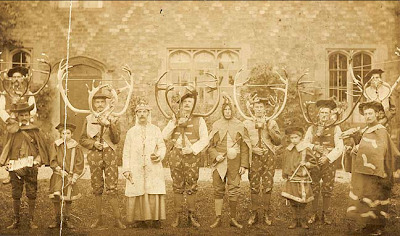
The Horn Dancers consist of the horn bearers, the Maid Marian, the Fool, a boy to keep time on triangle, and a boy with a bow and arrow. In recent years, girls have also been allowed to participate in the boys’ roles.
4. The May Queen can be a doll.
This is an interesting practice that bears a close resemblance to the Gaelic custom of making the Brideog doll on Imbolc. The Oxford Dictionary of English Folklore tells us:
The most widespread and best known May Day activity in the 19th and early 20th centuries was the children's garland custom. In essence, this involved groups of children visiting houses in their community showing a garland, singing a song, and collecting money. [...] A regular, but not ubiquitous, feature was to place a dressed and decorated doll (sometimes more than one) in the centre of the garland, or in front of it. She was usually called something like Her Lady, or The Queen, and treated with great respect. Commentators assume she represented the Virgin Mary. In some places, it was the doll which was given precedence, rather than the garland, transported in a decorated box or basket...
In this write-up from a UK newspaper, we're told:
There has been much debate about what the May Doll represents. Some believed it was the Virgin Mary, to whom the month was dedicated, others Flora or the May Queen. One of a group of young girls told a folklorist in Bampton, Oxfordshire in the 1970s that their doll represented a goddess whilst another in the group said it was Minerva! In Edlesborough, Buckinghamshire, two dolls, one smaller than the other, were carried in a covered decorated chair to resemble the Virgin and Child.
It also notes that in some counties, this doll was called "the Maulkin." Bringing this all back around, these etymology geeks claim that "maulkin" or "malkin" was once a common term for the young man dressed as the lady in May Day dances and parades. Guess playing dress-up was always the point.

What strikes me the most after learning all of this? Overall, traditional May Day festivities seem...almost diametrically opposed to the image presented to me by the pagan community, which was all about reinforcing strict gender roles. On the American side at least, I think a lot of pagan men would find the absence of a May King intolerable, and the presence of a drag queen unthinkable. In their minds, this can't be what their ancestors intended. If they can invent their own May Day to be more heavy metal, then they will do just that.
I am not here to say that old customs are good and new ones are bad. Many of the traditions described above were revived in the 1900s, by new communities who did new things with it. There were also debates in the mid-20th century, around whether women should be allowed to participate in May dancing, despite the fact that women were evidently involved both in its history and preservation. So it’s not as if the legacy of May Day is totally free of sexism or revisionism.
What I'm here to say is this: Sometimes, when a person claims to be practicing an ancient faith that's been passed down secretly through the country-ways of the common-folk, you have to ask yourself: what is it they're really advocating? Tradition? Clearly, tradition has no problem with unmarried girls or cross-dressing men. Nature veneration? Somehow, the seasons kept turning through all this. If someone is telling you a story about what your forebears practiced, believed, or valued - can you be sure they’re telling the truth? To the best of their ability? It's important to be sure, I think, if we sincerely want to honor the past.
❀
Extras:
Jack-In-The-Green Revisited
Quest For the Queens is a collection of BBC footage of May Day festivities in New Westminster, from the 1930s onward.
The Hayfield May Festival in 2011.
Nigel Pennick with a May garland and doll, plus a song on accordion.
#may day#beltane#wicca#I tried to post this earlier in the day#but I started disassociating really badly#I definitely don't have religious trauma#from the happy hippie religion#nope none at all#why is the last emoji so huge
63 notes
·
View notes
Text

EVENT : emergency lockdown
With the island still under attack, all civilians (students, faculty, and island residents) have been assigned a location on the island to shelter in. Location assignments have been sent to each phone. Characters receive only their own assignments, not the entire list.
Most guards have been summoned to fight the attackers; a handful of NPC guards have been assigned to find and deliver lost civilians to their assigned shelters; all player character guards have received orders to collect supplies from designated emergency locations and proceed to an assigned shelter to protect civilians. Guards assigned to the shelters have a list of all civilians assigned to their shelter and are expected to check each of them off on arrival.
Another explosion has left half of the dormitory building collapsed, and the other half quickly following. Characters may have been in the building when it collapsed, and escape plots/injury plots are allowed!
The island is under attack by Delphine Delecaille. While the protections were down, Delphine and many of her people made it onto the island. Among the attackers is a massive purple dragon--characters may witness the dragon flying over the island, breathing fire, but should not come up against it. They may, however, encounter as many NPC attackers of various species as you please on their way to their shelter. Characters can fight and kill NPC attackers without consulting the main and without fear of consequences!
Speaking of journeys to their shelters, your character may take any roundabout journey you like to arrive there, so long as they do, eventually, arrive there. Late arrivals are allowed. Characters may spend up to two (2) days outside of the shelter. After they arrive at the shelter, they will not be allowed out, though characters with teleportation will not be bound.
Characters will not be allowed into shelters they are not assigned to, even in the name of staying with their loved ones assigned there.
While the island is under attack, cell phones on the island are misbehaving. Texts and calls are failing 9 out of 10 times.
The protective spells have been restored, but the binding spell in particular is acting up. Bound slaves may find they have access to their powers in short spurts of up to ten or fifteen minutes at a time.
Keep your eyes peeled for plot drops throughout the event!
Lockdown locations & assignments are under the cut.
LOCKDOWN LOCATIONS
01. THE CAMPUS THEATER
ASSIGNED GUARDS: Ale Bolivar Vicente Sanchez & Liam Connolly
ASSIGNED CIVILIANS:
Alexander Black
Angelina Andrews
Belladonna Ivy
Clementine Astoria
Dakota Winters
Dominik Ruthingham
Donnie Miller
Dylan Altomare
Emmanuel Reyes
Evander Kasyade
Evelyn Stratford
Fayeth Araven
Finn Carlyle
Isabel Hai Phan
Jason Shaw
Jody Linnel
Jude Rigby
Judith Gilmore-Green
Layla DuBois
Leo Weatherington
Levi Matthews
Lucas Drake
Magnus Kusihamar
Malakai Nolan
Malon Savaris
Matthew Clarke
Nova Walker
Quinten Sawyer
Rowan Aubri
Sabrina Christiansen
Tessa Fuchs
02. THE CLINIC
ASSIGNED GUARDS: Uriel Zeriah & Milo Cole
ASSIGNED CIVILIANS:
Aiden Wentworth
Ava Montgomery
Chase Walker
Damien Black
Edmund Elofsen
Elijah Scott
Gabriel Mauchavant
Grace Carleton
Gulana Alim
Hunter Morrigan
James Donovan
Katell Brightwood
Keith Crane
Kylie Danvers
Lyssa Hudson
Margeaux Adkins
Orion Campbell
Qhuinn Fontenot
Sasha Bell
Sawyer Chambers
Scarlett McKnight
Stephen White
Sunshine Bunny
Tamara Von Uplnek
Tilly Beaumont
Tommy Heavyshield
Victor Hunt
Wat Fletcher
Theodora Wilson
Veritty Cailloux
Xavier Lennon
03. THE LIBRARY
ASSIGNED GUARDS: Kane Whelan & Raven Powers
ASSIGNED CIVILIANS:
Ace Kiran
Arthur Augustus
Atticus Carmine
Avery Fellhaven
Byron Christiansen
Charlotte Taylor
Ciaran O'Bryan
Clara Woodhouse
Daisy Lynch
Dhani Lyman
Dominick Winterford
Dougal McLeod
Elise Nyland
Elizabeth Garcia
Elliot Raws
Ethan Valdez
Everlasting
Felix Martin
Francesca Vanderbilt
Genevieve Wranmyer
James Storm
Kailor Grey
Leslie Stedeman
Lilim Morrigan
Noah Wright
Owen Jackson
Scott Landenberg
Skyler Campbell
Thalia Moore
Wade Jensen
Winter DuBois
8 notes
·
View notes
Text






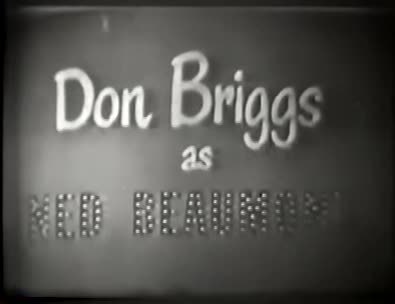

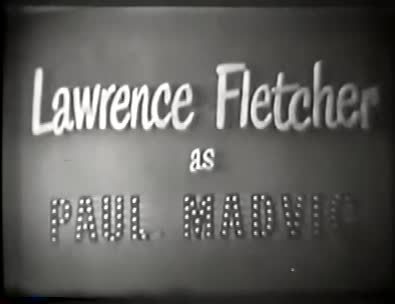

The Glass Key - CBS - May 11, 1949
A presentation of Westinghouse Studio One Season 1 Episode 13
The Premier Episode under Westinghouse Sponsorship
Drama
Running Time: 60 minutes
Stars:
Don Briggs as Ed Beaumont
Jean Carson as Janet Henry
Lawrence Fletcher as Paul Madvic
Les Damon as Shad
Edwin Jerome as Senator Henry
Sara Taft as the Nurse
Bern Hoffman as Jeff
Joe Silver as Whiskey
Maurice Gosfield as Harry
Joseph Latham as Mike
3 notes
·
View notes
Photo



Marbled Monday
This Marbled Monday our marbling has an unsettling vibe. This green, yellow, black, and red marbling with little gold flecks adorns the cover of The Maides Tragedy by English dramatist Francis Beaumont (1584-1616) and John Fletcher (1579-1625) with wood engravings by Scottish artist Freda Bone (1905-1991) which we shared in a previous post. The book was printed in 1932 for Cheshire House in an edition of 1200 copies, but the play was originally published in 1619.
Frankly, I find this marbling somewhat unpleasant and it gives me a swampy feeling—I’m thinking the boiling lake that Grendel lives in/under from Beowulf. It is closest to either a Schrottel or Shell pattern, but appears to have been swirled a bit at the end of the process creating this uniquely stylized pattern.
View more Marbled Monday posts.
-- Alice, Special Collections Department Manager
#Marbled Monday#The Maides Tragedy#The Maid's Tragedy#Francis Beaumont#John Fletcher#Freda Bone#Cheshire House#Schrottel Pattern#marbling#marbled paper#Shell pattern#Alice
48 notes
·
View notes
Text

Hence, All Ye Vain Delights by Francis Beaumont and John Fletcher, from The Family Library of Poetry and Song edited by William Cullen Bryant, 1886
#hence all ye vain delights#quote#typography#literature#poetry#dark academia#aesthetic#beaumont and fletcher#francis beaumont#john fletcher#the family library of poetry and song#william cullen bryant#17th century#1600s#english literature#melancholy
2 notes
·
View notes
Text
EMERGENCY HOUSING !
The Delecaille Administration is pleased to announce that emergency accommodations have been made for those residents unhoused by damages to the island.
Our sincerest thanks to the generous island residents opening their homes.

HOST: Ace Kiran - Home
Felix Martin
Tessa Fuchs
HOST: Ciaran O'Bryan - Home
Lilim Morrigan
HOST: Daisy Lynch - Home
Dylan Altomare
HOST: Emmanuel Reyes - Home
Tilly Beaumont
Rowan Aubri
Freddie Buckley
HOST: Evelyn Stratford - Home
Gulana Alim
HOST: Everlasting - Home
Ale Bolivar Vicente Sanchez
HOST: Fayeth Araven - Home
Elise Nyland
Malon Savaris
HOST: Grace Carleton - Home
Thalia Moore
Scarlett McKnight
Katell Brightwood
HOST: James Donovan - Home
Lyssa Hudson
Kylie Danvers
HOST: Jason Shaw - Home
Atticus Carmine
Theodora Wilson
HOST: Magnus Kusihamar & Jude Rigby - Home
Orion Campbell
Finn Carlyle
Owen Jackson
James Storm
Judith Gilmore-Green
Sawyer Chambers
Evander Kasyade
Genevieve Wranmyer
Leo Weatherington
Malakai Nolan
Winter DuBois
HOST: Markus Christiansen - Home
Nova Walker
Xavier Lennon
Hunter Morrigan
HOST: Noah Wright - Home
Isabel Hai Phan
Charlotte Taylor
Avery Fellhaven
HOST: Quinten Sawyer - Home
Sasha Bell
Kane Whelan
HOST: Scott Landenberg - Home
Wat Fletcher
Ste White
6 notes
·
View notes
Text
"love lies bleeding" was NOT beaumont and fletcher's "philaster or love lies a-bleeding" (1609). at the same time it wasn't not that
5 notes
·
View notes
Text
Episode 22: Laura Estill on Dramatic texts, Commonplace books, and Profane & debauched atheists

“Profane, & Debaucht Atheists” (Bodleian MS Sancroft 29, p. 1)
In Episode 22 of Inside My Favorite Manuscript, Dot and Lindsey talk with Laura Estill about Bodleian MS Sancroft 29. Archbishop of Canterbury William Sancroft (1617-1693) was an avid reader and collector of extracts from various works. MS Sancroft 29 is one of many manuscripts in his hand that survives; it is a dramatic commonplace books, that is, it contains bits and pieces of many plays that Sancroft read most of them from the century before Sancroft lived, including Shakespeare. We learned so much about the reception of drama in the seventeenth century, and we hope you enjoy listening to our conversation.
Listen here, or wherever you find your podcasts
Below the cut are more images and links relevant to the conversation.
English Treasury of Wit and Language (1655) by John Cotgrave, with marginal attributions added; image from https://www.journals.uchicago.edu/doi/epdf/10.1086/696155:

Bodleian MS Sancroft 97 with extracts from 2 Henry VI quarto (labelled Yorke & Lancaster “pt 1” in margin):
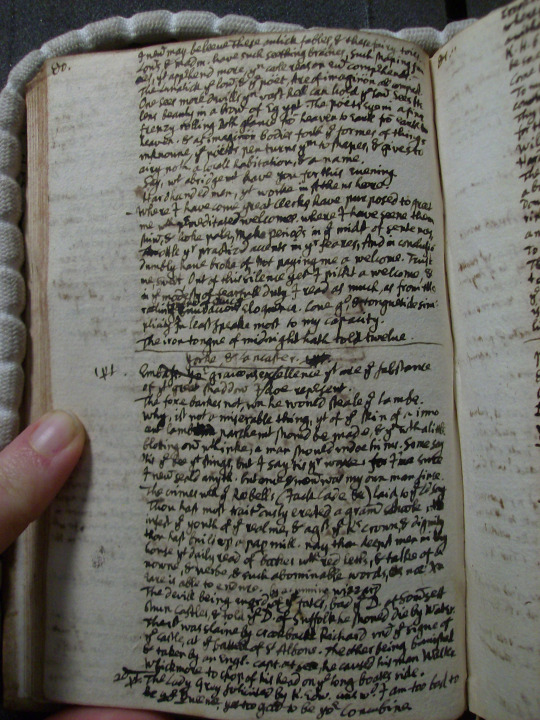
Foxe’s preprinted commonplace book, Pandectae Locorum Communium (1572), empty page (floods, water) – source, EEBO:

Foxe’s preprinted commonplace book, Pandectae Locorum Communium (1572), full page (tribulations, vexations)—source, EEBO:

Sancroft’s abandoned list of playes (Bodleian MS Sancroft 29, f. i):
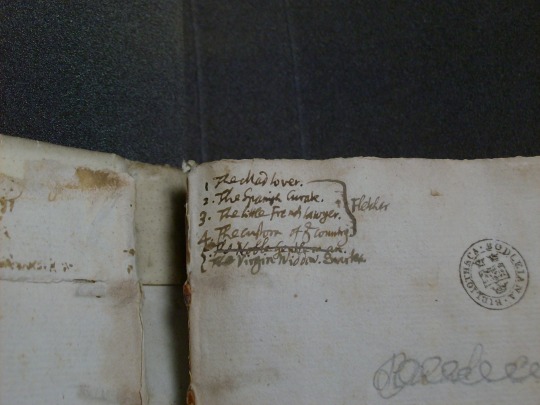
“Profane, & Debaucht Atheists” (Bodleian MS Sancroft 29, p. 1):

Extracts from Heywood’s A Maidenhead Well Lost (top) and Webster’s Devil’s Law Case (most of page), (Bodleian MS Sancroft 29, p. 69):

Epilogue to Jonson’s Every Man in His Humour in a verse miscellany (Bodleian MS Sancroft 53, p. 6):

Links to projects mentioned in our discussion:
1664 Shakespeare Folio title page & Frontispiece:
1647 Beaumont and Fletcher Folio Table of Contents:
2 Henry VI quarto:
#manuscript#17th century#drama#dramatic texts#commonplace book#commonplace journal#journal#podcast#imfmpod
15 notes
·
View notes
